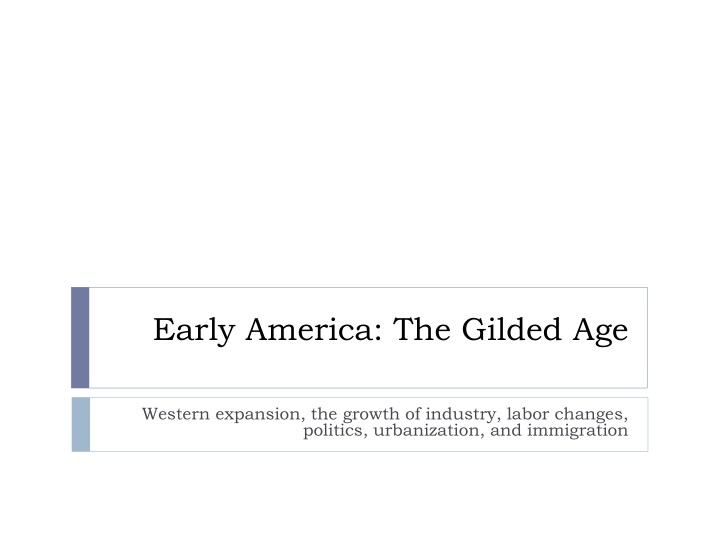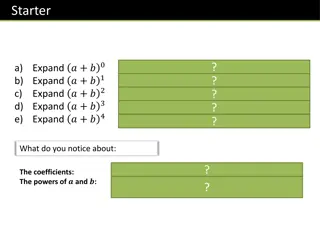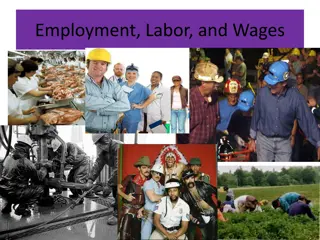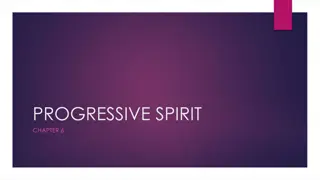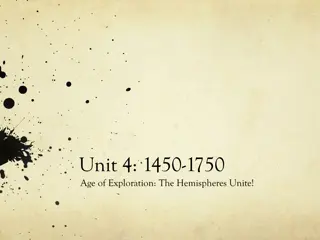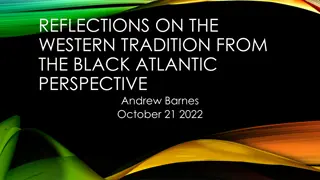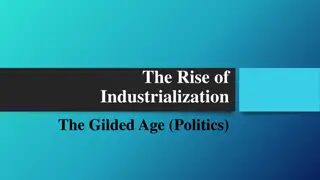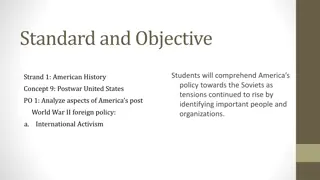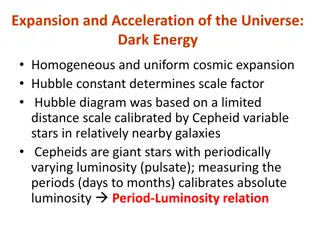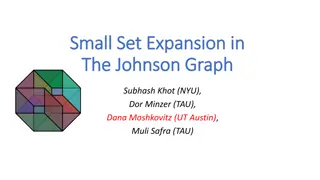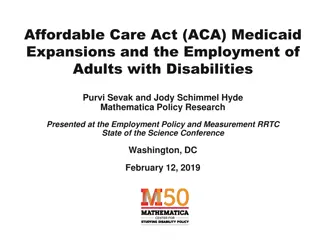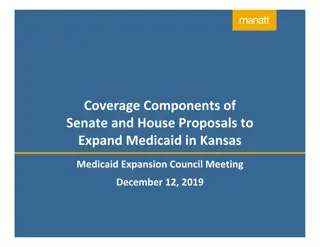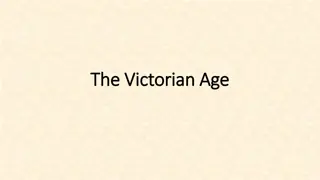The Gilded Age in Early America: Western Expansion, Industrial Growth, and Social Changes
The Gilded Age in Early America saw significant Western expansion, industrial growth, labor changes, urbanization, and immigration. Americans moved west for various reasons, such as the search for gold, land grants for railroads, and new farm technology. Inventions like the telegraph revolutionized communication, while the motion picture projector offered new forms of entertainment. This period marked a transformative era in American history.
Download Presentation

Please find below an Image/Link to download the presentation.
The content on the website is provided AS IS for your information and personal use only. It may not be sold, licensed, or shared on other websites without obtaining consent from the author.If you encounter any issues during the download, it is possible that the publisher has removed the file from their server.
You are allowed to download the files provided on this website for personal or commercial use, subject to the condition that they are used lawfully. All files are the property of their respective owners.
The content on the website is provided AS IS for your information and personal use only. It may not be sold, licensed, or shared on other websites without obtaining consent from the author.
E N D
Presentation Transcript
Early America: The Gilded Age Western expansion, the growth of industry, labor changes, politics, urbanization, and immigration
Western Expansion What allowed Americans to fully expand west? Conflicts with Native Americans were diminishing New pathways for citizens to travel Oregon Trail (by wagon) Railroads Gov t gave land grants to RR companies (e.g. Central Pacific & Union Pacific) Employed thousands of workers (increased immigration) By the mid 1880s, several transcontinental railroads were built Increased business connections Encouraged travel
Western Expansion Why did Americans want to move west? Gold! Thousands went to western states like CA searching for gold and other valuable minerals Western cities grew rapidly (SanFran); some were later abandoned (Bodie) Farmland & new farm technology Homestead Act (1862) gov t gave away160-acre plots of land 1837=John Deere s steel plow, 1841=William Pennock s grain drill, 1842=Joseph Dart s grain elevator,1847=Cyrus McCormick s mechanical reaper New life Exodusters African Americans who moved from the South to the west New industries Cattle ranching (learned from Mexico) Open land, Texas longhorn cattle accustomed to prairie env., growing demand for beef, cowboys hired to drive cattle along specific routes
New Inventions Improve Life The creation of new inventions helped fuel the trend of industrialization and change in society Many different categories: Farm technology Factory machinery Communication Leisure/recreation Transportation
New Inventions Improve Life Telegraph Invented by Samuel B. Morse in 1838 (constructed in 1844), based on earlier ideas of Henry, Cooke, and Wheatstone Improved by Cyrus Field came up with the idea of laying telegraph cable under the ocean so America could communicate with Europe IMPACT: Made it possible for individuals to communicate much faster (took minutes, not days or weeks!), more easily and on a broader scale than ever before.
New Inventions Improve Life Motion picture projector Invented by Thomas Armat and Charles Francis Jenkins (who worked with Thomas Edison to market it) in 1896 IMPACT: allowed whole groups of people to watch a series of moving pictures (what we later know as movies!); this became a big source of entertainment in many cities
Natural Resources & New Industries Resources plentiful in the U.S.: Lumber (southeast & west) Water (shorelines & many rivers/lakes) Iron ore & coal (Appalachian Mountains) Oil (southwest; first found in PA) Industries Steel manufacturing Textile mills Coal Oil
New Industries & Business Tactics Railroad industry expanded Abuse of power? George Pullman railroad factory owner; built an entire town for his workers, but tightly controlled their lives; led to the violent Pullman Strike in 1894 Union Pacific railroad company that created their own construction company ( Cr dit Mobilier ), then paid them 2 or 3X the normal rate to build track; owners pocketed the profit and gave stock to Congressmen (including James Garfield, future US President)
New Industries & Business Tactics Grangers members of a farmers organization called for gov t regulation of railroad co.s Claimed RRs misused land grants, fixed prices, and charged unfair rates Granger laws Allowed the gov t to regulate RR rates and policies Upheld in Munn v. Illinois (1877); est. the gov t s right to regulate private business to serve the public interest Led to the ICC (Interstate Commerce Commission) Supervised RR activities Limited success in controlling RR co.s RRs began to collapse financially Mismanagement, corporate corruption Led to an economic collapse in the 1890s; many RR co.s were bought out by financial co.s (JP Morgan)
New Industries & Business Tactics Businessmen of the 1800s Andrew Carnegie John D. Rockefeller Use your textbook, pg. 241-244, to create a profile of one of these businessmen; then share with a neighbor who profiled the other. Include their industry, new tactics used, and other important details. Trust-busting Trust = several companies merged under one trust , where trustees run one large corporation. Each company then gets a share of the trust s profits. Sherman Antitrust Act (1890) Learning log: read pg. 244 and explain how effective this Act was & why
Industries and Labor Urbanization: shift in population pattern from rural to urban concentration People came to cities from the countryside (as agriculture and small-scale jobs faded) and from other countries (for work or a better life) Pros Many new industrial jobs available Most required limited skill or training Cities grew (economically, culturally) Cons Poor working conditions No labor regulation from the gov t Cities grew (overcrowding, disease, crime)
Industries and Labor Most jobs were in factories or mills (sweatshops) Long hours (12+ hrs/day, 6 days/week), even for children Low wages (~$10/week for avg. steel worker) Unpleasant conditions Dirty, poorly ventilated, poorly lit Boring, repetitive tasks Unsafe environments Heavy, hard-to-use equipment resulted in MANY accidents 1907: from July 1906 through June 1907 JUST in Allegheny County, PA 526 workers died in work accidents 1912: The National Safety Council est.18,000 21,000 workers died from work-related injuries Many workers got sick No insurance, sick days, workers comp.
Industries and Labor Workers began organizing to ensure rights Fought for better pay, shorter hours, job security, safe conditions NLU (National Labor Union), 1866 Fought for an 8-hour work day; approved in 1868 by Congress CNLU (Colored National Labor Union) Knights of Labor, 1869 An injury to one is the concern of all ; ~700,000 members Open to all; fought for equal pay for equal work AFL (American Federation of Labor), 1886 Joined workers from various skilled trades Collective bargaining (negotiations b/t labor rep.s & management) Strikes (refusing to work until demands are met) Achieved shorter work weeks & higher wages 1890: $17/week, 54.5 hrs/week 1915: $24/week, 49 hrs/week Many groups (farmers, immigrant workers, miners) formed unions
Industries and Labor Famous events (pg. 247-249) Haymarket riot, 1886 What were they protesting? What happened? How did the public react? Homestead Strike, 1892 What company? Who were strikebreakers? Pullman Strike, 1894 What industry? Why did the strike fail? Results? Triangle Shirtwaist Factory fire, 1911 What happened & why? How did the public & gov t react?
Urbanization Many groups migrated to cities in the NE & Midwest Immigrants Cities were cheap & convenient, often located along waterways Unskilled jobs available Had ethnic neighborhoods (security & culture) Farmers Fewer workers needed on mechanized, commercial farms Jobs and cultural opportunities (school, religion, leisure) African Americans Many had relied on farm jobs Escaping racial violence (only mildly better in northern cities) These groups brought new culture & diversity, but also competition & tension
Urbanization Problems & solutions Lack of affordable, safe housing Laws set standards for plumbing, ventilation, etc. in apartments (not always effective) Lack of safe & efficient transportation Mass transit networks built (cable cars, streetcars, subways) Unsafe drinking water Public waterworks added filtration and chlorination Lack of sanitation Developed sewer lines and established sanitation departments
Urbanization Fire hazards Created full-time, pro. fire depts Automatic fire sprinklers More buildings made from brick & stone instead of wood Crime Created full-time, pro. police depts Social Gospel movement = reform movement based on religious duty to serve the poor & improve society Created settlement houses (community centers that provided assistance to impoverished citizens) Run by middle-class, educated women Jane Addams & Ellen Gates Starr founded Hull House in Chicago Provided education, health, and social support ~400 nation-wide by 1910
Immigration Old wave Mid-1800s; mostly from N & W Europe New wave Late 1800s-1920; from S & E Europe, Asia, South & Central America/Caribbean Using your book (Ch. 7 Sect. 1), summarize the arrival of people from these places of origin. Include: # of immigrants, countries they came from, push/pull factors, where they entered & lived in the U.S. Europe Asia S. & C. America & the Caribbean
Immigration European (Italy, Austria-Hungary, Russia southern & eastern) 20 million (1870-1920) Came through Ellis Island (NY) Push factors: Population boom in Europe (overpopulation, job & resource scarcity), religious persecution Pull factors: jobs, American freedom & opportunity Asian (China, Japan, Oceania) 300,00 Chinese (late 1800s); 200,000 Japanese (early 1900s) Pull factors: Gold rush, jobs (railroad), higher wages, annexation of HI Came through Angel Island (San Fran, CA) S./C. America & Caribbean (Mexico, Jamaica, Puerto Rico, Cuba) 260,000 from the Caribbean (1880-1920) Pull factors: unskilled jobs (farming, industrial), National Reclamation Act opened more farmland in SW Push factors: scarcity of jobs, political & social upheavals (revolutions)
Farmers & the Populist Party Economic trouble for farmers Crop prices were falling Good farmland was scarce Couldn t make mortgage payments; banks foreclosed on properties Railroads were charging high fees for shipping Gold, silver, and the money debate Paper money retains value when it is backed by a metal standard Rep. favored gold standard (backing paper $ only with gold) Dem. favored bimetallism (back with gold OR silver) Silver was more plentiful More money in circulation; hoped to stimulate economy
Farmers & the Populist Party Farmers organize to push for reforms Grangers, Farmers Alliances Wanted gov t control of banks & regulation of railroads Formed the Populist Party in 1892 The movement of the people; popular with farmers & laborers Platform: Increase $ supply; bimetallism Graduated income tax Low interest federal loans Election of Senators by popular vote Single-term presidency Improved working conditions (8-hr day) Limits on immigration
The Highs & Lows of City Life Political corruption Political machines (organized groups that controlled the activities of political parties in cities) active in many major cities Offered favors, jobs, and bribes to those who supported their agendas Could provide positive services to city dwellers; usually engaged more in graft for their own gain Ex: Boss Tweed = leader of Tammany Hall (political machine in NYC) Patronage (giving gov t jobs to people who helped a candidate get elected) People were not chosen based on merit many were unqualified Countered by Pendleton Civil Service Act (1883) created a bipartisan commission to appoint people to federal jobs based on their qualifications, not their political ties
The Highs & Lows of City Life Segregation & discrimination Jim Crow laws (legal segregation of races) Voting restrictions, segregated public facilities Supported by Plessy v. Ferguson in 1896 Supreme Court case that upheld separate but equal laws as legal Social discrimination Surge in racial violence South: lynching, often w/o trial (some 1,400 from 1882-1892) North: segregated neighborhoods, job discrimination, race riots Mexican & Chinese immigrants particularly targeted over jobs
The Highs & Lows of City Life Amusement Parks To provide outdoor space for activities in/near cities Coney Island NY Bicycling Began as a male-only sport Safety bicycles had smaller wheels & air-filled tires Women got new clothing to allow them to cycle, too No longer needed a chaperone could get around town themselves Susan B. Anthony was a supporter Boxing Gave people an escape from work; encouraged social listening gatherings; live matches very profitable Famous boxers: John Sullivan, Gentleman Jim Corbett
The Highs & Lows of City Life Baseball Created an avid fan base of spectators; offered an escape from work Nationwide leagues formed: National League, American League, Negro leagues Shopping centers Offered a wide variety & large quantity of manufactured goods; many went for leisure (to window shop) Earliest shopping center = 1890 in Cleveland, OH (included jewelry stores, leather goods, and an arcade) Department stores Offered personalized service & a variety of goods all in one store Marshall Field opened the first one in 1865 in Chicago
The Highs & Lows of City Life Chain stores Offered the same goods, same prices, & same ownership in different locations; could offer low prices b/c goods were bought in bulk F.W. Woolworth = chain store owner, 1870s Mail-order catalogs Brought department store merchandise to people OUTSIDE the city; people who could not get to the stores could order through the mail Rural free delivery US Post Office delivered catalogs & packages to rural areas for free Sears & Roebuck, Montgomery Ward (1870s) Expansion of written news Yellow journalism (sensational reporting style used by newspaper) provided wide-spread distribution of news to people in many areas; criticized as too sensational & not always factual; but increased interest in nationwide news
